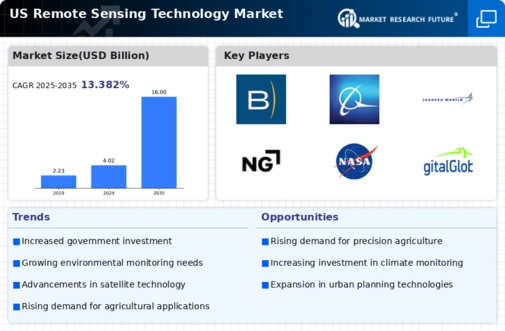Rising Demand for Geospatial Data
The remote sensing-technology market is witnessing a rising demand for geospatial data, driven by various industries seeking to leverage location-based insights. Sectors such as agriculture, urban planning, and disaster management are increasingly utilizing geospatial data to enhance operational efficiency and decision-making processes. The market for geospatial analytics is projected to grow at a CAGR of 15% through 2028, indicating a robust appetite for data-driven solutions. This trend is likely to propel the adoption of remote sensing technologies, as organizations recognize the value of integrating geospatial data into their strategies. Consequently, the remote sensing-technology market is positioned to benefit from this growing demand for comprehensive geospatial information.
Expansion of Commercial Applications
The remote sensing-technology market is experiencing an expansion of commercial applications, as businesses across various sectors recognize the value of remote sensing data. Industries such as agriculture, real estate, and energy are increasingly adopting remote sensing technologies to optimize operations and improve decision-making. For instance, precision agriculture relies on remote sensing data to enhance crop yields and resource management. The commercial segment of the remote sensing-technology market is anticipated to grow at a CAGR of 10% from 2025 to 2030, indicating a robust trend towards the integration of remote sensing solutions in business practices. This expansion is likely to drive further innovation and investment in the remote sensing-technology market.
Growing Environmental Monitoring Needs
The increasing focus on environmental monitoring is a significant driver for the remote sensing-technology market. With climate change and environmental degradation becoming pressing global issues, there is a heightened demand for technologies that can monitor and assess environmental conditions. Remote sensing technologies provide critical data for tracking deforestation, water quality, and air pollution. In the US, the market for environmental monitoring is expected to reach $5 billion by 2026, reflecting a growing recognition of the need for sustainable practices. This trend underscores the vital role that remote sensing plays in supporting environmental policies and initiatives, thereby driving growth in the remote sensing-technology market.
Technological Advancements in Sensor Design
The remote sensing-technology market is experiencing a surge in technological advancements, particularly in sensor design. Innovations such as miniaturization and enhanced sensitivity are enabling the development of more efficient and accurate sensors. These advancements are likely to improve data collection capabilities, thereby expanding the applications of remote sensing technologies across various sectors, including agriculture, forestry, and urban planning. The market for remote sensing sensors is projected to grow at a CAGR of approximately 12% from 2025 to 2030, indicating a robust demand for cutting-edge sensor technologies. As organizations increasingly rely on precise data for decision-making, the importance of advanced sensor design in the remote sensing-technology market cannot be overstated.
Increased Investment in Defense and Security
The remote sensing-technology market is significantly influenced by increased investment in defense and security applications. Governments and defense agencies are recognizing the strategic importance of remote sensing technologies for surveillance, reconnaissance, and intelligence gathering. In the US, defense spending on remote sensing technologies is projected to exceed $10 billion by 2027, reflecting a commitment to enhancing national security capabilities. This investment is likely to drive innovation and development within the remote sensing-technology market, as new applications and technologies emerge to meet the evolving needs of defense and security sectors. The emphasis on advanced remote sensing solutions is expected to create substantial growth opportunities in the market.






















Leave a Comment